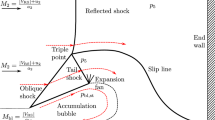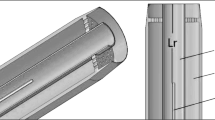Abstract
We present a theory of stagnation-point spray flame ignition by an isothermal hot surface. A mixture of fuel droplets and air flowing against an isothermal hot surface (such as a hot ignition probe) is considered. The spray of droplets is modelled using the sectional approach, and a mono-sectional case is adopted for simplicity. A single global chemical reaction is assumed for the case when ignition occurs. The mathematical analysis makes use of a small parameter that is exploited for an asymptotic approach. The analysis produces a criterion for ignition that includes effects of the flow field, the reactants and the fuel spray-related parameters. Numerical computations reveal the way in which the spray impacts on whether ignition will occur or not.







Similar content being viewed by others
References
Neophytou A (2010) Spark ignition and flame propagation. PhD dissertation, University of Cambridge
Aggarwal SK (2014) Single droplet ignition: theoretical analyses and experimental findings. Prog Energy Combust Sci 45:79–107
Kikby LL, Schmitz RA (1966) An analytical study of the stability of a laminar diffusion flame. Combust Flame 10:205–219
Linan A (1974) The asymptotic structure of counterflow diffusion flames for large activation energies. Acta Astronaut 1:1007–1039
Matalon M, Ludford GSS (1979) Chambered diffusion flames for different supply temperatures. Acta Astronaut 6:1377–1386
Aggarwal SK, Sirignano WA (1984) Modeling of chemical and mixing effects on methane autoignition under direct-injection, stratified charged conditions. Proc Combust Inst 20:1773–1780
Aggarwal SK, Sirignano WA (1986) Ignition of poly-disperse sprays: importance of D20. Combust Sci Technol 46(3–6):289–300
Aggarwal SK (1988) Ignition and flame propagation in dilute polydipserse sprays: importance of \(d_{32}\) and \(d_{20}\). AIAA J Propuls 4(1):14–21
Neophytou A, Mastorakos E, Cant RS (2011) Complex chemistry simulations of spark ignition in turbulent sprays. Proc Combust Inst 33:2135–2142
Law CK (1978) On the stagnation-point ignition of a premixed combustible. Int J Heat Mass Transf 21:1363–1368
Chen ZH, Lin TH, Sohrab SH (1988) Combustion of liquid fuel sprays in stagnation-point flow. Combust Sci Technol 60(1–3):63–77
Hsu A-K, Lin TH (2003) A stagnation-point gasoline-spray premixed flame. Combust Sci Technol 175(12):2141–2159
Matkowsky BJ, Sivashinsky GI (1979) An asymptotic derivation of two models in flame theory associated with the constant density approximation. SIAM J Appl Math 37(3):686–699
Buckmaster JD, Ludford GSS (1982) Theory of laminar flames. Cambridge University Press, Cambridge
Law CK (2006) Combustion physics. Cambridge University Press, New York
Silverman I, Greenberg JB, Tambour Y (1993) Stoichiometric and polydisperse effects in premixed spray flames. Combust Flame 93:97–118
Chung PM (1965) Chemically reacting non-equilibrium boundary layers. Academic Press, New York, Advances in heat transfer
Greenberg JB, Silverman I, Tambour Y (1993) On the origins of spray sectional conservation equations. Combust Flame 93:90–96
Williams FA (1985) Combustion theory. The Benjamin/Cummings Publishing Company Inc, Menlo Park
Dvorjetski A, Greenberg JB (2002) Steady state and extinction analyses of counter-flow spray diffusion flames with arbitrary finite evaporation rate. Combust Sci Technol 174(8):143–164
Labowsky M (1980) Calculation of the burning rates of interacting fuel droplets. Combust Sci Technol 22:217–226
Imaoka R, Sirignano WA (2004) Vaporization and combustion in three-dimensional droplet arrays. Proc Combust Inst 30:1981–1989
Imaoka R, Sirignano WA (2005) A generalized analysis for liquid-fuel vaporization and burning. Int J Heat Mass Transf 48:4342–4353
Imaoka R, Sirignano WA (2005) Transient vaporization and burning in dense droplet sprays. Int J Heat Mass Transf 48:4354–4366
Chiang CH, Sirignano WA (1986) Interacting, convecting, vaporizing fuel droplets with variable properties. Int J Heat Mass Transf 36(4):875–886
Chiang CH, Sirignano WA (1993) Axisymmetric calculations of three-droplet interactions. Atom Sprays 3(1):91–107
Wu G, Sirignano WA (2011) Transient convective burning of a periodic fuel-droplet array. Proc Combust Inst 33:2109–16
Wu G, Sirignano WA (2011) Transient convective burning of interactive fuel droplets in single-layer arrays. Combust Theor Model 15:227–243
Wu G, Sirignano WA (2011) Transient convective burning of interactive fuel droplets in double-layer arrays. Combust Flame 158:2395–2407
Silverman I, Sirignano WA (1994) Multi-droplet interaction effects in dense sprays. Int J Multiph Flow 20(1):99–116
Abramzon B, Sirignano WA (1989) Droplet vaporization model for spray combustion calculations. Int J Heat Mass Transf 32(9):1605–1618
Sirignano WA (1999) Fluid dynamics and transport of droplets and sprays. Cambridge University Press, Cambridge
Linan A (1985) Theory of droplet vaporization and combustion. In: Borghi R, Clain P, Linan A, Pelce P, Sivashinsky GI (eds) Modelisation des Phenomenes de Combustion. CEA-EDF INRIA 59. Editions Eyrolles, Paris, pp 73–103
Sanchez AL, Urzay J, Linan A (2015) The role of separation of scales in the description of spray combustion. Proc Combust Inst 35:1549–1577
Sharma OP, Sirignano WA (1969) Ignition of stagnation point flow by a hot body. Combust Sci Technol 1(2):95–104
Stull DR, Prophet H (1971) JANAF thermochemcial tables. NSRDS-NBS-37, 2nd edn. National Bureau of Standards, Washington, DC
Vargaftik NB (1975) Tables on the thermophysical properties of liquids and gases, 2nd edn. Wiley, New York
Acknowledgements
JBG thanks the Lady Davis Chair in Aerospace Engineering for partial support of this research.
Author information
Authors and Affiliations
Corresponding author
Rights and permissions
About this article
Cite this article
Kats, G., Greenberg, J.B. Stagnation-point spray flame ignition by an isothermal surface. J Eng Math 110, 181–194 (2018). https://doi.org/10.1007/s10665-017-9947-1
Received:
Accepted:
Published:
Issue Date:
DOI: https://doi.org/10.1007/s10665-017-9947-1




